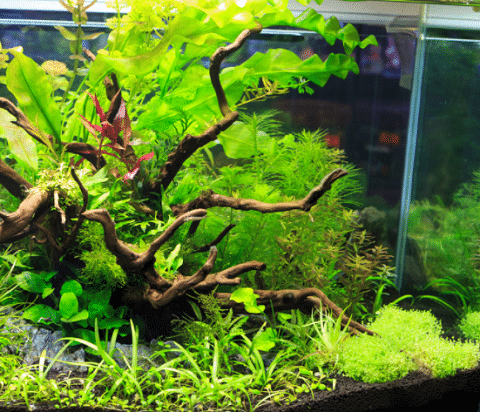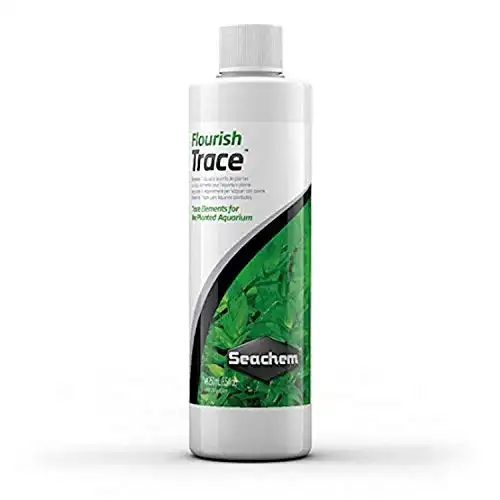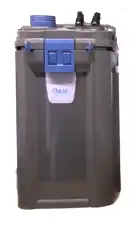Thank you for visiting! By the way… any links on this page that lead to products on Amazon and other stores/partners are affiliate links Aquarium Store Depot earns a commission if you make a purchase.
In the quest for the most beautiful planted tank, aquarists have long experimented with getting the perfect dosing schedule down that ensures optimum plant growth, without plant deficiencies and minimal algae. You’ve probably heard of dosing liquid fertilizers and root tabs, but there is another way of managing the nutrient levels in your tank.
The Estimative Index (EI) is a more measured and hands-on approach, but it is great for the more advanced aquarist who takes plant growing seriously and is ready to take the aquarium hobby to the next level. In this article, I’ll break down exactly how it works, and teach you everything you need to know to get you started.
What Is The Estimative Index Method?
The Estimative Index (EI) was developed by Tom Barr in the mid-1990s1. The index (dosing rates) was developed through experimentation and the beauty of the system is that it is proportional to aquarium water volume, so you can apply the index to any planted aquarium size.
This technique provides an excellent general starting point, but it can also be customized to suit the characteristics of your setup. Essentially, this method of plant fertilizing involves overdosing all the nutrients your plants need on a consistent basis and then performing large weekly water changes to reset the parameters.
By doing this you will not need to test nutrient values because your values will stay in a relatively stable range, week after week.
Benefits of This Method

The system is designed to remove the need to rely on a test kit, which can be inaccurate anyway unless you have expensive calibrated equipment. In a nutshell, the goal of the system is to provide your plants with complete nutrition, at repeatable and consistent levels.
The EI system works on the assumption that algae growth is not triggered by high nutrient levels, but more often from an imbalance of CO2. This may sound like an odd statement until you consider that one of the best ways to out-compete algae growth is to have vigorous competition from healthy aquatic plants.
Supplying more nutrients prevents the development of plant deficiencies so naturally, it makes sense to boost your plant performance as much as possible.
Who Is it For?
The Estimative Index method is especially useful for high-light tanks that are heavily planted. This applies in particular to high-tech setups that have stable levels of CO2 from injection systems that match the lighting period of the tank.
Without the high energy conditions created by high lighting and added CO2, increased nutrient levels will not be as effective. Still, it is possible to use the principles of EI in low light tanks, but the strength and frequency of the dosing will need to be decreased
EI is not necessary for aquarists who just keep a few low-light plants in their fish tanks and are happy with the results they achieve. Instead, this is a system for growers with a high light tank that want to get the most out of their plants. That means achieving the fastest growth and the best color, all while seriously reducing algae growth.
Although this system does have some pretty substantial start-up costs, the raw materials will last a long time, saving you plenty of money in the long run when compared with dosing liquid fertilizers at similar concentrations.
EI And Fish Safety
The method appears to be perfectly safe for fish since nitrates are kept around the standard 20ppm mark and CO2 levels are maintained at or below the safe level of 30ppm. Performing large, regular water changes is very important, however, to reset the tank to reduce excess nutrient levels and manage the ammonia introduced by decaying plant parts and fish waste.
Dosing

The reason why the EI dosing levels are so scaleable is that they are proportional to water volume, rather than measured in a set value like milligrams or ounces. The dosages are described in parts per million(ppm) per week and are estimated to cover the maximum potential nutrient uptake rates for aquarium plants.
I understand this might be getting a little complicated at this point, so read on for a breakdown of exactly what these terms mean.
How Is PPM Calculated?
Ppm is a simple way of describing a concentration. For example, 1 milligram of a powder mixed with 1 liter of aquarium water creates a concentration of 1 part per million, pretty simple right?
What Is Nutrient Uptake?
Nutrient uptake is a very important concept to understand when discussing the EI Method. Nutrient uptake is simply the amount of nutrients a plant can take out(uptake) from the aquarium water column in a defined period.
Let’s take a look at an example to help explain this concept:
You have one healthy aquarium plant in your tank and you dose a certain nutrient to a concentration of 20 ppm. The next day, you measure the concentration of the same nutrient and find that the concentration has dropped to 15ppm.
You are now able to calculate the plant’s nutrient uptake rate and it can be described as 5 ppm per day. Since ppm is a ratio, this measured nutrient uptake rate will apply to your plant in your specific tank size.
What Affects Nutrient Uptake Rate?
- Different plant species have different potential growth rates. Fast-growing stem plants have a much higher nutrient uptake rate than slow-growing epiphytes for example.
- As light intensity increases, photosynthesis increases, placing more demand on the plant’s nutrient stores to produce sugars.
- As with light, carbon dioxide availability is essential for the process of photosynthesis to occur. Both must be in balance, and therefore, high light will create an increased demand for CO2.
- Plant mass and size- The larger a plant, the greater its nutrient uptake potential will be.
The Goal Of EI Nutrient Dosing
The goal of EI nutrient dosing is to guarantee that your plants are never deficient in any of the nutrients that they need. In other words, the plant’s maximum nutrient uptake levels are always available in the aquarium water.
The recommended dose concentrations are designed to match the maximum amount that plants can potentially use in a very high light planted aquarium. This doesn’t mean that they will necessarily use all of these nutrients in the water column, it just means that there is no benefit in adding any more.
Another great benefit of EI dosing is the prevention of algae blooms. If you dose consistently, your healthy plants will out-compete algae, now that’s a win-win!
Recommended Dosage Rates
The ideal nutrient levels that you will try to maintain in the water column when using the EI method are as follows:
- Carbon Dioxide (CO2): 20-30ppm per week
- Nitrate (NO3): 20 ppm per week
- Potassium (K): 10-30 ppm per week
- Phosphate (PO4): 1-2 ppm per week
- Magnesium (Mg): 10 ppm per week
- Iron (Fe): 0.5 ppm per week
These uptake rates were measured under the maximum level of light intensity that plants can use for photosynthesis. What this means is that whether you have moderate light, or high-intensity lighting, the dose rates above will always provide enough nutrients to your plants.
The fact that your planted aquarium probably has a lower intensity of light and your plant’s actual nutrient uptake rate is lower does not matter.
What You Need To Use This Method
A major difference between using regular liquid solutions and root tabs, and using the EI method is the consistency of the nutrients. In this case, you will be using each nutrient in its pure dry powdered form. It is up to you to mix them up or dose them individually at the right concentrations.
Purchasing the chemicals is pretty expensive, particularly because you will need a few of them to get started properly. If you do the math though, and you’re serious about maintaining a heavily planted aquarium, you’ll actually be saving a lot of money in the long run.
Macro-nutrients For Plant Growth

Macronutrients are the substances needed by plants in relatively high concentrations. Here’s what they are called and what they do for your plants:
- Potassium Nitrate
This compound is a source of Potassium and nitrogen for your plants. Nitrogen is vital for chlorophyll production and photosynthesis. It promotes the health and growth of the above-ground parts of the plant.
Potassium is essential for the transport of substances within the plant as well as for the process of photosynthesis. It maintains a plant’s resilience and strengthens it at a cellular level.
- Potassium Phosphate
Phosphorus is vital for healthy root development in plants and helps plants to store energy. It is also necessary for successful photosynthesis and to promote vigor and resilience in plants.
- Magnesium Sulfate
Magnesium and sulfur are secondary macronutrients which means that they are needed in lower quantities than nitrogen, phosphorus, and potassium(NPK). They are still essential in the planted aquarium for healthy growth though.
Magnesium is the most important component of chlorophyll, and without it, photosynthesis would not be possible. Sulfur is also necessary for chlorophyll formation and allows plants to make use of nitrogen.
Magnesium sulfate is an optional macro for the EI method, but is useful if you have very soft water as it can be effective in boosting GH. It is also a good idea to dose magnesium sulfate if you use reverse osmosis(RO) water.
Micro-nutrients For Plant Growth
Micronutrients are trace elements that are also essential for healthy plants but needed in much smaller amounts than macronutrients. The most important trace elements are:
- Iron
- Zinc
- Manganese
- Molybdenum
- Copper
You can use Plantex CSM+B as your source of trace elements or use a liquid product like Seachem Flourish.
A great aquarium fertilizer for getting essential trace elements into your planted tank. Readily available in stores
Dosing Equipment
Apart from a collection of dry fertilizer powders, you need very little equipment to use the EI method. The dry fertilizers themselves will need to be measured pretty accurately. A set of small measuring spoons and a scale will come in handy for this, although you can get by using just a teaspoon.
You can dose the dry fertilizers directly into the water column, or if you prefer, you can also mix them into a liquid solution. If you prefer to make liquid solutions, some small bottles and a funnel will come in handy. For large aquarium, it could make sense to investing in a dosing system.
Aquarium Lighting
The dosage values that are recommended for the EI method were developed for plants grown under very high light. While you will get the best results in high light tanks, you don’t need to have extremely high light.
Low light tanks, however, will not benefit from this system if you are adding way more nutrients than the plants can use due to limited photosynthesis potential.
CO2 Injection
To achieve optimum plant growth by using the EI method, you will need to run a carbon dioxide injection system in your tank. You should aim for a CO2 concentration of no more than 30ppm to ensure the safety of your livestock.
The most reliable way to achieve stable levels is to use pressurized CO2 with a drop checker and a bubble counter. A diffuser will be necessary to make this vital gas easily available to your plants.
CO2 is only used by your plants during photosynthesis, and this means that your system should only run while your lights are on. It does take a little while for the gas to build up to optimum levels though, so the best thing to do is run your pressurized injection system on a separate timer that starts up about 2 hours before the lights go on, and then shuts off when the lights go out.
Filtration For The Planted Aquarium
In a planted aquarium with high light and excess nutrients in the water column, excellent filtration becomes very important. This is because the filter is not only necessary for processing uneaten fish food and fish waste as in a traditional fish tank.
In such a high-energy planted aquarium, the plant material can also be a source of ammonia. Wet/dry filters and canister filters tend to be the best options for this type of setup. OASE Biomasters are great filters to consider.
The Pro's Choice
The top choice among professional aquascapers. German engineering and equipped with an intregrated heater.
Water Hardness
For the EI system to be effective, you will need a carbonate hardness of at least 3-5 °KH and a general hardness of about the same. This usually is not a problem if using tap water, but if you use reverse osmosis(RO) water in your tanks, or your area has naturally soft water, you will need to remineralize the water.
How To Dose With This Method
One of the major differences between the EI method and other feeding routines is the high frequency of application. This is a hands-on approach that requires you to dose daily and dose consistently.
If you cannot commit to dose daily, 2-3 times a week is also acceptable though. The idea is that your plants do much better with a constant supply of nutrients, rather than the occasional boost.
A typical EI routine consists of dosing macro-nutrients, and micro-nutrients (trace elements) on alternate days for 6 days, then performing a water change on the 7th day.
As an example, an EI schedule could look like this:
- Monday: Dose macronutrients
- Tuesday: Dose micronutrients (trace elements)
- Wednesday: Dose macros
- Thursday: Dose micros
- Friday: Dose macros
- Saturday: Dose Micros
- Sunday: Perform 50% water change and dose a GH booster if using reverse osmosis (RO) water
It is important to dose your macros and micros on separate days because when added together, the chemicals can interact in ways that make them unusable for your plants.
Water Changes
The usual advice is to perform a 50% weekly water change but you can also increase this up to 75% if you prefer. In a healthy and very large tank, you can even decrease your water changes to twice or even once a month. Ideally though, you want to follow a routine that is repeatable and reliably shows results.
How To Perform A Water Change
For aquarists, water changes are just a fact of life. A 50% weekly water change might sound a little extreme, but they are necessary to ‘reset’ your nutrient concentrations. Under the high energy growth conditions associated with high lighting and CO2 injection, high levels of ammonia (and therefore nitrates) are produced.
When performing your weekly water change, be sure to turn off your equipment like filters and heaters. You can use this opportunity to vacuum the substrate and carpet plants to remove any physical waste in the tank. This is also a great time to trim your plants and siphon out all the trimmings so that they do not rot in your tank.
When the time comes to refill, try to make sure that the water you add to the tank is as close as possible to the temperature of the water still in the tank. This will minimize any temperature shock on your livestock. You should also condition your tap water to neutralize any harmful chemicals it might contain.
EI vs PPS
Now that you know what the EI system is and what it is used for, you may be wondering if there are other systems that can be used. You might have heard of another popular fertilizing technique called the Perpetual Preservation System, but the two are really very different.
While the EI method intentionally overdoses by providing the maximum possible amount of nutrients that a plant can use, the PPS system attempts to dial in the numbers and limit any excess nutrients in the water column.
Essentially, EI is designed to maximize plant growth and accepts that major water changes will be necessary to reset the water parameters and maintain a consistent nutrient level.
PPS is not an attempt to create maximum plant growth, but rather to establish a system that is self-sustaining and does not require water changes.
EI Aquarium Calculator
While it is possible to calculate your dosages yourself, it is much easier to use this dedicated online EI calculator. Go ahead and play around with this calculator to help you understand the sort of amounts of each nutrient you will need to add on a daily and weekly basis for your aquarium size.
FAQs
What is EI?
Estimated Index is a fertilization system developed by Tom Barr in the 1990s that is designed to promote maximum plant growth in aquarium plants. The idea is to provide the maximum nutrient levels that the plants can potentially use, and maintain these levels continuously.
How do I use dry fertilizer in my aquarium?
Once you have measured the amount of dry fertilizer that you need to dose for the day, you can simply dissolve it in some tank water and then add it to your planted aquarium. You can even add the powder directly to the water.
What is a perpetual preservation system?
The perpetual preservation system(PPS) is a fertilizing system for the planted aquarium that attempts to minimize excess nutrients in the water column and make it possible to maintain a healthy tank that does not need water changes.
What are macronutrients in aquarium plants?
Macronutrients are the nutrients like nitrogen, phosphorus, and potassium that plants need in the largest amounts.
Final Thoughts
If you’re looking for the ultimate manual control over the plant growth in your aquarium, while preventing the dreaded algae bloom, the EI system is just what you’re looking for. This is a very hands-on method that is not suited to the casual aquarist or someone looking for a low-maintenance aquarium.
If you have the time and the passion and want to grow your fully planted tank to its full potential, this is definitely a great solution for you!
- About the Author
- Latest Posts
I’m thrilled that you found Aquarium Store Depot! Here you’ll find information on fish, aquariums, and all things aquatics related. I’m a hobbyist (being doing this since I was 11) and here to help other hobbyists thrive with their aquariums! I adhere to a high quality Editorial Process and Review products with real life field usage and practical analysis.







